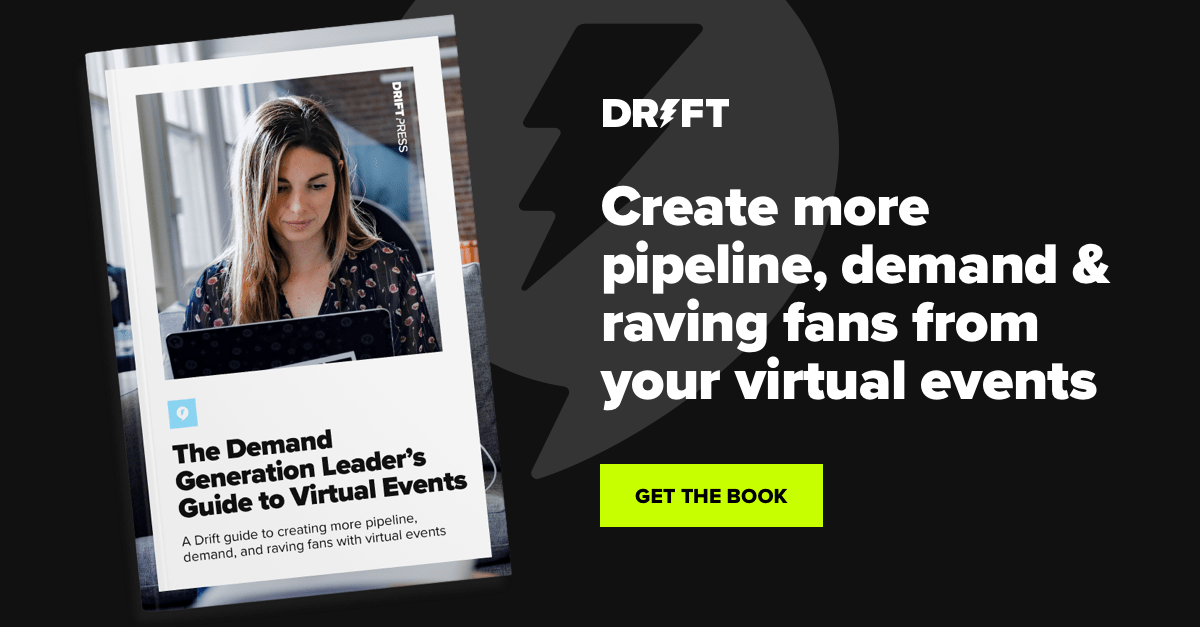From streamlining team comms to upping qualified registrations, we’ve learned a ton about managing virtual events.
Here are some of the things we’ve learned the hard way:
- Not everyone loves yoga
- The right theme will boost all your metrics
- Event curation wins out over event stuffing
Along the way, we continue to share these lessons internally, on our blog, and in Drift Insider – we even created an entire certification on virtual events (more on that here 😎).
Today – right here, right now – we’ve pulled together our all-time favorite tips and (gulp) some of our mistakes.
In this guide to virtual events management, you’ll find our framework for running events, plenty of essential to-dos, and also some things not to do.
How Drift Manages Virtual Events
We’d hate to dive straight into the tips and mistakes without laying down some common ground.
If you’ve read our blog for any length of time, you know we love a good framework.
Our Virtual Events Management Framework breaks down tasks into three phases:
- Pre-Event
- Showtime
- Post-Event
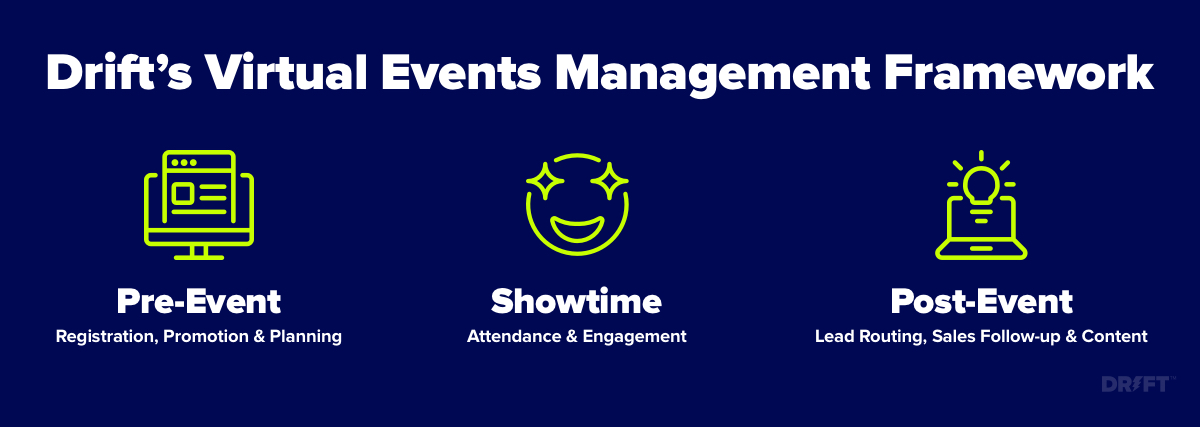
1. Pre-Event: Registration, Promotion & Planning
In the pre-event stage, it’s all about coming up with a great theme for the event, mapping out the marketing plan, and writing the copy.
These are some of the key activities that we do in this phase:
- Ideate a theme based on a product launch or industry update
- Create a thorough brief
- Choose the right virtual events platform
- Plan speaker content
- Promote and drive registrations
2. Showtime: Attendance & Engagement
When it’s showtime, we work on increasing show-up rates with FOMO-inducing email notifications. Plus, we set up a channel for live communication as a team. We also collaborate with social media managers and SDRs to make sure that we’re engaging with participants both on social media and in the event’s chat.
Here are some of the things we do in this stage:
- Increase show-up rates with notifications
- Communicate internally
- Get participants to network with each other
- Engage on social media
- Engage in the event chat (especially SDRs)
At every stage, we track important metrics like the number of registrations, the attendance for each session, and the pipeline generated.
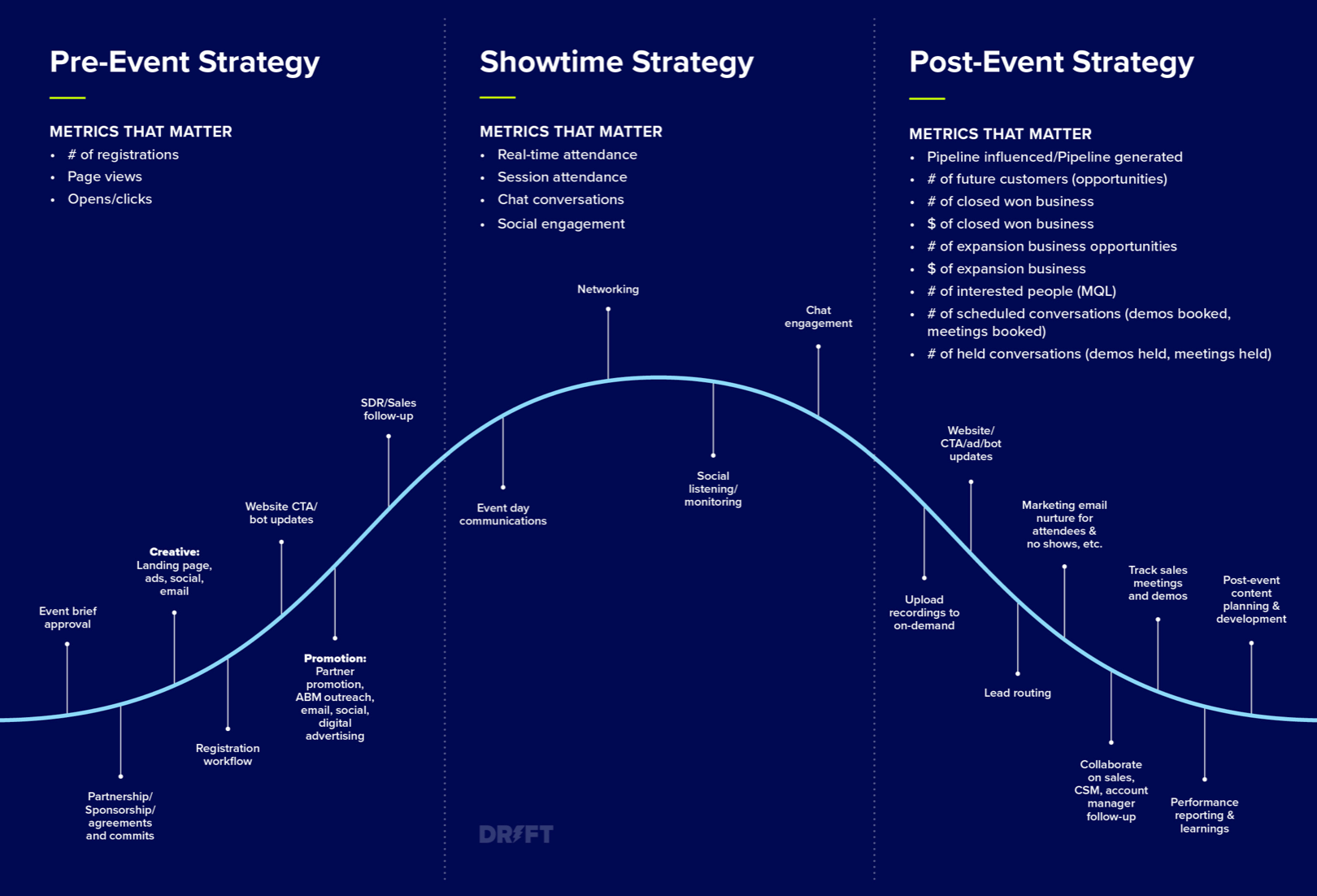
3. Post-Event: Lead Routing, Sales Follow-up & Content
After the event, it’s time to make sure that traffic gets re-routed to evergreen funnels and on-demand content. We also segment event leads and follow-up with them according to their priority, which is based on how well they match our ideal customer profile (ICP) and their level of engagement with the event.
We make sure to:
- Release on-demand content
- Revert traffic from registration materials to the right evergreen CTAs and bots
- Follow-up with event leads
- Share lessons internally
- Repurpose lessons into external marketing content
Check out our Virtual Events Certification, which covers the entire process from end to end 👇
Team Brief: How to Create a Virtual Event Brief That Guides All Collaborators
The brief is super important.
Your brief should guide everyone: the content marketing team, the demand gen team, the virtual events management team, the sales team, the social media manager, everyone.
I collaborate with the program owner and a copywriter to create a very detailed brief. The inspiration might come from a new product launch or an industry topic we want to get ahead of.
Here’s what we put in the brief:
- Event theme
- Event name
- Event description
- Target audience
- What the event experience will include
- Production requirements
- Actual copy for the landing page
- Sample invitation email copy for various segments of our email list
- Goals for all registration counts and qualified lead registrations
- The virtual events platform we plan to use
We get our CMO to review the brief and sign off on it. After that, the brief can go to all of the implementers.
This way, there are only three or four people involved in the brief process, so there aren’t too many cooks in the kitchen. Everyone else gets involved in implementation after many key details have been ironed out and approved.
Event Tech: How to Choose the Right Platform for Running Your Virtual Event
The right platform will not only provide an engaging experience for your attendees, but also give you the insights you need to convert those attendees into customers.
When hunting for a platform, check that it integrates with the systems you use. For us, we need it to integrate with Drift (of course) and with Marketo. This allows us to deliver highly personalized sales and marketing experiences before and after the event.
These are some of the top features to look for in virtual events management software:
- Great video quality
- Event chat
- Deep analytics
- Toolkit integrations
- Fully brandable
- Downloadable resource management
- Live and pre-recorded videos
- Roundtables and breakout rooms
- White glove customer success

*Some virtual events platforms we love include Goldcast, On24, Bizzabo, and Welcome.
Our All-time Favorite Tips for Increasing Registrations
Want more people to register for your virtual event? Here’s how to ramp up those sign-ups.
Create a Theme Your Audience Can’t Resist
Let’s address the elephant in the room. Your event theme can’t be a dud and produce stand-out registration numbers. It’s just not going to happen.
Here’s a simple hack for coming up with a great topic: think of something in your industry that everyone wants to be good at. Now, take that thing and elevate it. Come up with an expert spin.
For example, for one recent RevGrowth, we covered account-based engagement, an emerging concept that marries account-based marketing with account-based sales.
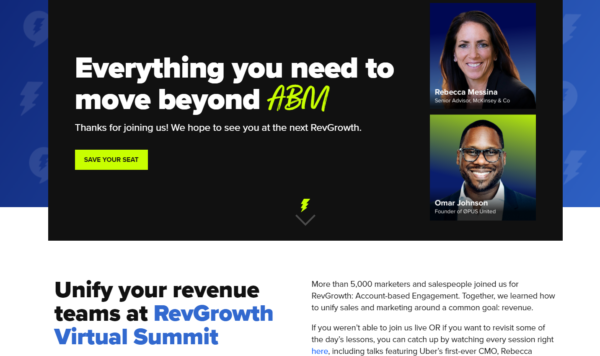
Invite Speakers from Brands You Want to Be Associated With (and Who Your Audience Admires)
Elevating your event theme is always a great move. So is elevating your speaker list. Invite people from brands that you want to be associated with and that your audience admires.
You’ll notice that at Drift we’ve started inviting more leaders from B2C companies. That’s because although we sell B2B, we want to be seen alongside the top brands. This reinforces that we’ve got a big mission (and we do).
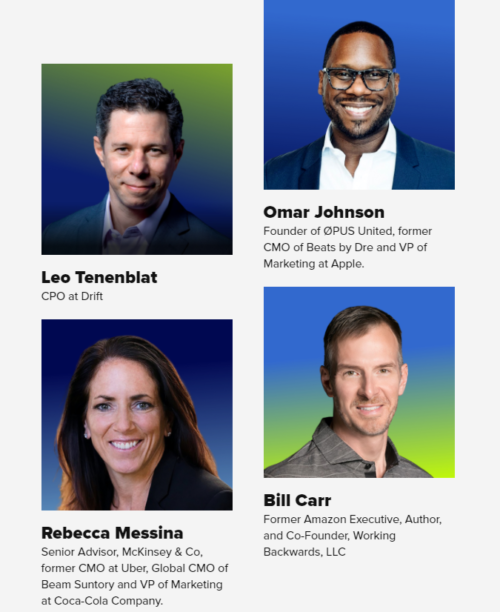
Use Social Proof to Create Hype and FOMO
Your event’s registration page shouldn’t look like just another virtual event wandering around the wasteland of the internet. It should look like something that shouldn’t be missed.
We create this FOMO with social proof. Grab testimonials from event attendees on Twitter and add them to your event swipe file to use again and again.
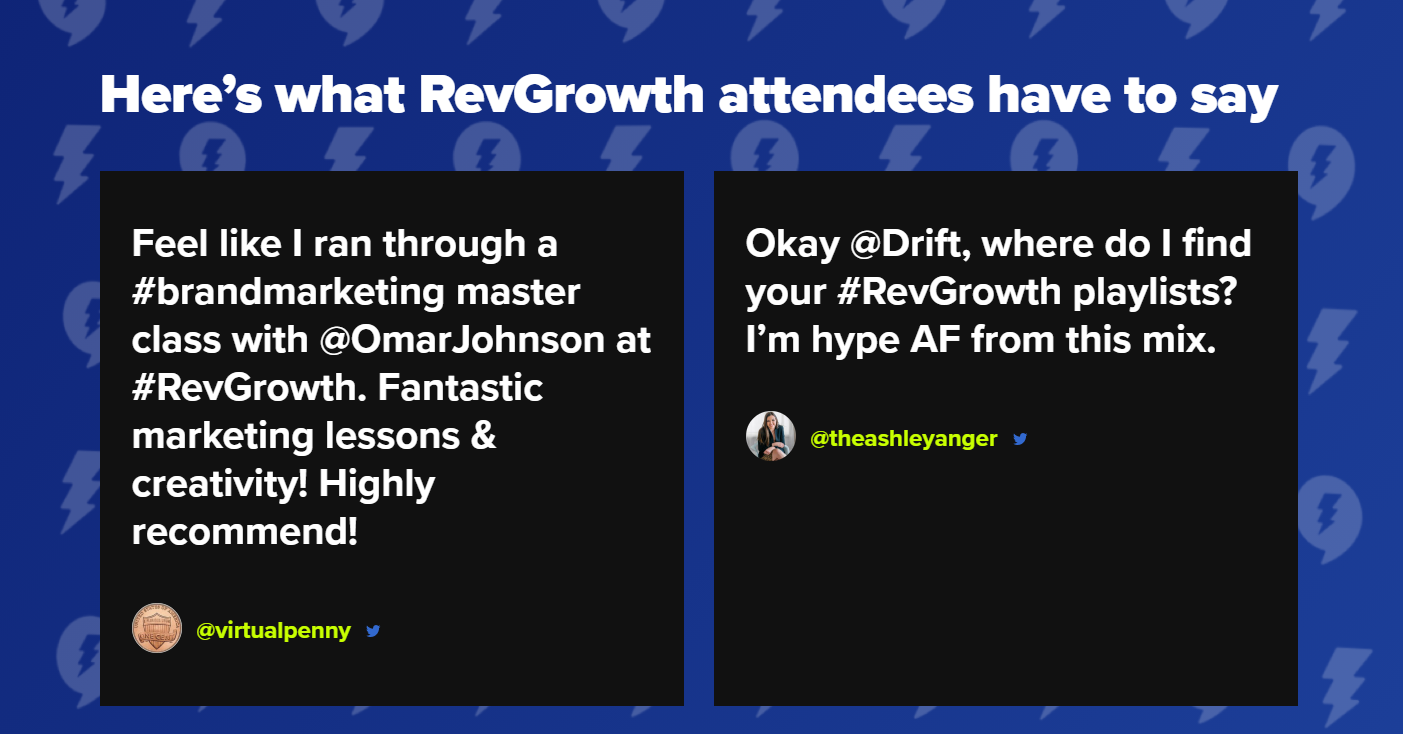
Test and Optimize Registration Driftbot Copy
We don’t use forms to get sign-ups. Instead, we use Drift chatbots, and this dramatically improves our conversion rates (our recent page converted at a rate of 86%).
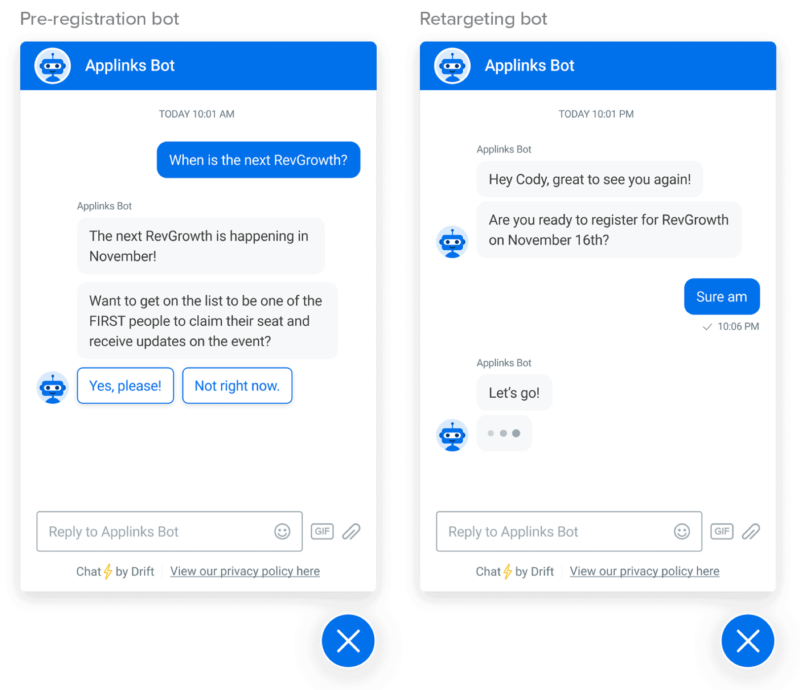
But we don’t stop there. We continually test and optimize our copy for both our pre-registration bots and our re-targeting bots.
In one recent test, we discovered that stating the number of days until the event (rather than the date of the event), improved our sign-ups.
“Our next RevGrowth is less than XX days away! Have you registered yet?!👀”
The countdown-timer feeling helped induce that FOMO feeling which is so crucial for event marketing.
Leverage Partnerships to Get More Qualified Registrations
Yes we send segmented invitations to our email list and yes we run ads for events, but our all-time favorite strategy for getting qualified registrations? It would have to be partnerships.
This is a very underutilized strategy for driving leads.
Partnerships can be leveraged in two ways, via sponsorships or co-marketing. Here at Drift we leverage both.
Co-Marketing: This is typically a free agreement that requires partners to drive a specific amount of leads to unlock certain parts of the list (like attendees) or the full list depending on the agreement.
Sponsorship: This is typically a paid agreement that requires minimal leads to be driven but allows the sponsor to have their brand highlighted, or even partake in the event depending on the agreement.
Here’s an example email that a partner sent out:
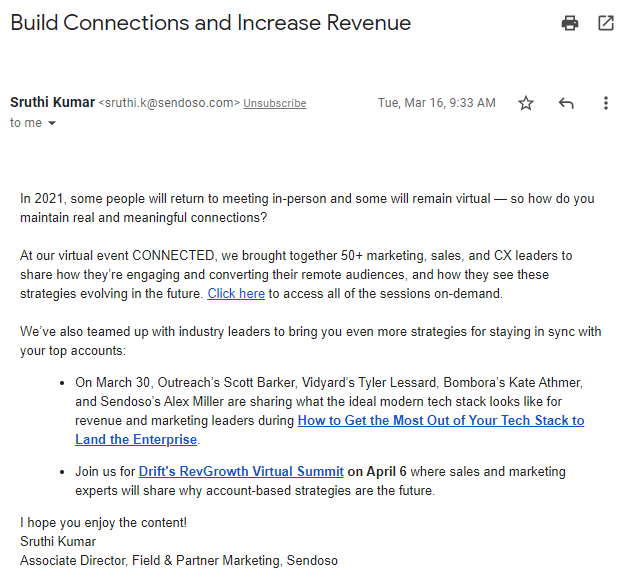
Our All-time Favorite Tips for Bumping Your Show-up Rates
If you want to drive leads from your virtual event, then people need to attend your virtual event, not just sign up for it. When someone actually attends, that is a very meaningful interaction with your brand and it can prime them to become a customer.
Here are three ways to bump those show-up rates.
1. Balance Inspiration and FOMO in Post-Registration Emails
Please don’t send boring post-registration emails. Add some excitement.
In your emails, you can remind people why they should attend, drop important details, and incentivize them to participate and engage.
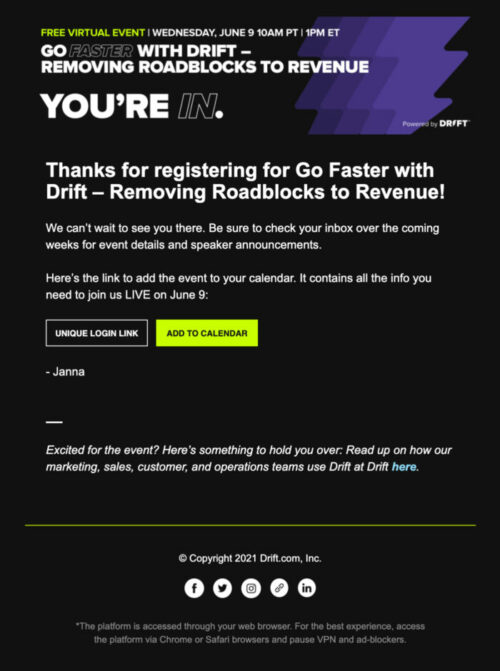
2. Allow Participants to Add Individual Talks to Their Calendar
The simple truth is that most people will not attend every aspect of your event. Your target audience probably has a lot on their to-do list.
If you allow people to add individual talks to their Google or Outlook calendar, you’ll increase the likelihood of them attending what they are interested in. They will see the name of that talk in their calendar and remember why they signed up.
If they can only add the entire event, they might forget the keynote headlines and ditch it altogether.
3. Increase Show-Up Rates with Multiple Reminders
One or two reminders aren’t enough. Instead, plan to send around seven reminder emails. These should begin a couple of weeks before the event to help people recall why the event is important, and what they’ll get out of attending.
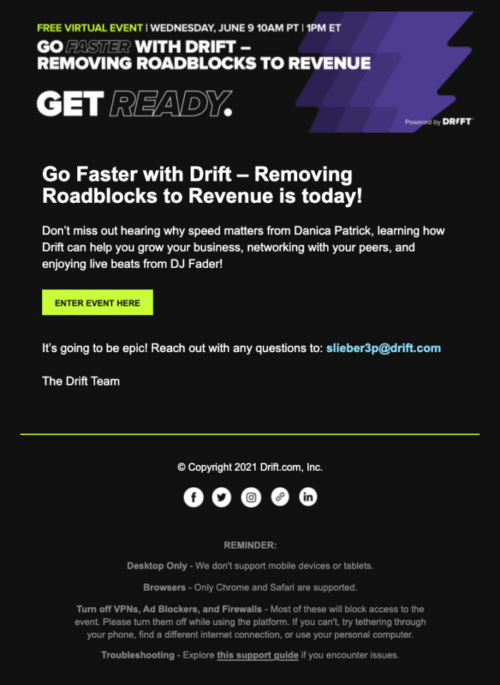
Our All-time Favorite Tips for Engaging Participants
Driving registrations is only half the battle.
Here are our all-time favorite tips for engaging with participants.
1. Be Super Active in Event Chat and Get Meetings Booked
We make sure we have both community managers and SDRs in the event chat to answer questions and highlight great comments.
SDRs will also engage with individual participants privately to book meetings. We don’t wait until after the event. SDRs book meetings while the event is happening live ⚡️
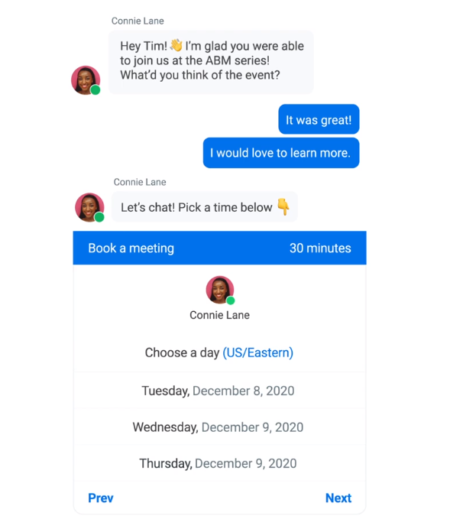
Here’s how you can use Drift for your next virtual event to drive registrations, engage attendees, and book meetings.
2. Offer a VIP Experience for Target Accounts
For our target accounts, we’ll invite them to a special VIP experience at the very end of the event. This is typically a roundtable or panel with wine tasting swag that we deliver to their door.
“We have a wine tasting company deliver wine to our top-tier accounts (after they’ve said yes to attending the event), and we enjoy the experience together. People want to be in the right rooms. You can curate the right groups of people by inviting people of similar roles (but from non-competitors) to an informal roundtable to learn from one another and get the inside scoop of what’s working.”
3. Hire a Killer DJ to Pump Up the Energy
We’ve had DJ Fader at many of our events, in-person and virtual. Why? Because he’s that good. He plays music during the breaks and helps ramp up the energy before a new speaker takes the stage.
It’s crucial to have high-energy music at a virtual event. Otherwise, it won’t feel like a live experience, and your live attendee count will drop.
Our All-time Favorite Tips for Following Up with Leads
Your event can help customers make better use of your products and services. It can also help you convert brand new people into leads and customers.
These are our three go-to strategies:
1. Segment Your Post-Event Emails for Attendees, No-Shows, and Non-Registrants
Don’t send the same post-event emails to everyone who signed up for your event.
Instead, segment your messages into three groups:
- Attendees
- Registered no-shows
- Non-registered

For attendees, you can offer new content offers that will be relevant and help them take the next step. For registered no-shows, give them the event content in a variety of formats. And for people who didn’t register, debrief them and offer micro-content and highlights so they can still experience some quick wins.
2. Build Funnels for Categories of Qualified Event Leads
Your sales team will need to review all registrants to find qualified leads. Your virtual events platform should also provide engagement data to help you find your fans.
Breakdown your virtual event lead list into three distinct tiers:
- High-intent, ICP accounts
- Engaged, but non-target accounts
- Non-ICP, low intent accounts
Within all three tracks, use data from your virtual event (such as what session they attended or what session they likely missed) to customize the messaging.
For your tier one track, you can send completely personalized messages. For the tier track, try to personalize a few important elements across the funnel. And for tier three, you can send follow-ups without much personalization.
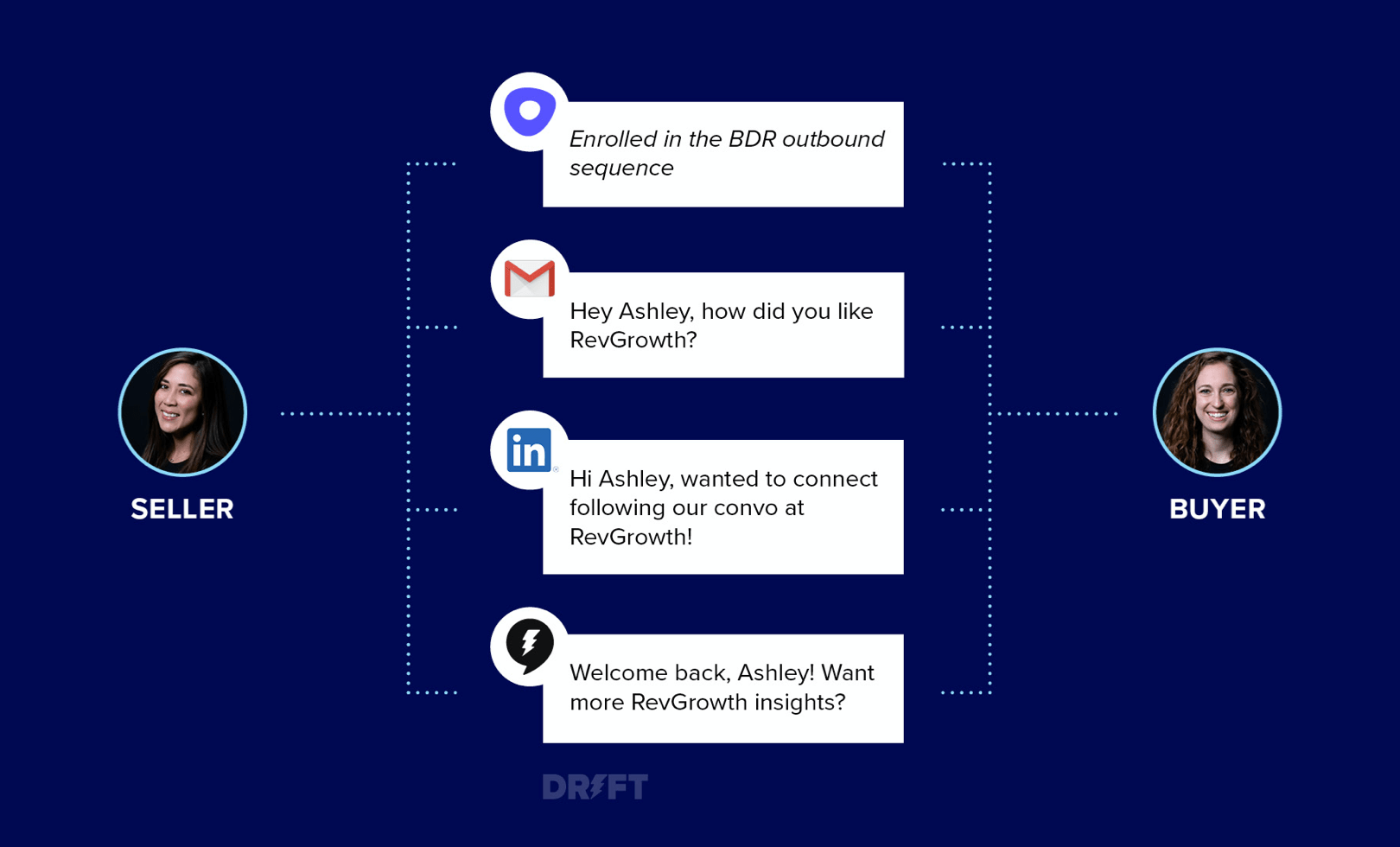
3. Enable Sales with Post-Event Content
What comes next?
Your event should be part of an integrated marketing campaign that pulls together the right content into a cohesive experience.
We turn most of our events into ebooks and courses.
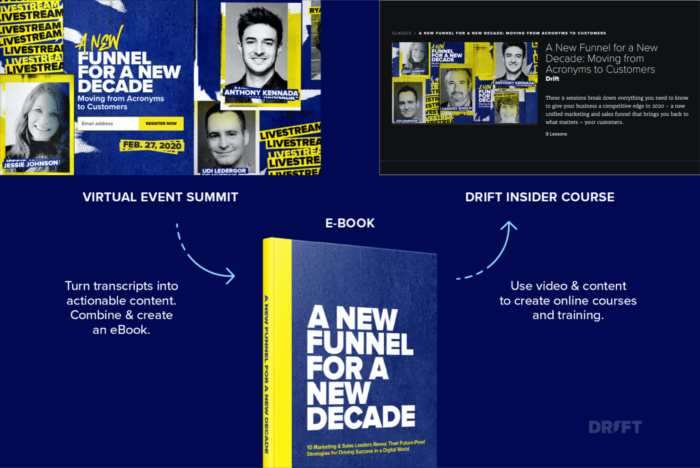
This helps us continually generate lots of expert-level content. Make sure the sales team knows which assets could be a great next step for leads who attended the event, and ones who signed up but didn’t attend.
For example, a lead who attended could receive a different ebook in a follow-up email, but one who attended might be better off getting the e-book version of that event when it is ready.
Mistakes We’ve Made (and What We’ve Learned From Them)
Well, folks. Nobody’s perfect.
Here are four crucial lessons we’ve learned along the way:
1. Don’t Offer Pay-to-Play Speaking Spots (Run Sponsored Commercials Instead)
While most sponsored talks are great, sometimes you’ll run into talks that are too salesy or simply not relevant enough to the theme of your event. This can leave a bad impression on your attendees, who might feel like you don’t value your time.
Instead, offer to run 2 to 3-minute commercials for your sponsors and curate invitation-only talks.
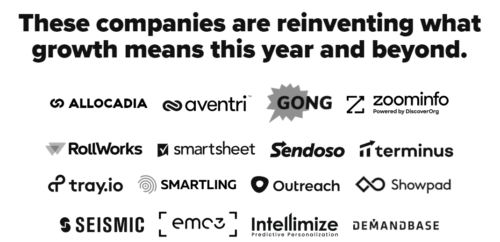
2. Don’t Overdo the Side Activities (They’re Not Necessary)
Hold the theatrics.
Yoga, exercise routines, and other tricks are more likely to distract and bore your audience than engage them.
Most B2B audiences value their time above such activities. They would rather attend a shorter event and go to the gym after work—not mix a downward dog routine into professional development.
3. Don’t Rely on Async Communication Only (Hold Weekly Standups)
We use Asana for the nitty-gritty task details, and there are a lot of them. But we found the hard way that running everything using asynchronous communication (when two people are commenting at different times on their terms) is a big mistake. In our first couple of events, there was a lot of confusion about who was doing what, and just a little bit of finger-pointing.
To fix this, we have a weekly stand-up for everyone involved in the event to go over the high-level implementation. The added bonus is that a marketing leader can pop into one of these meetings and get up to speed quickly on what is going on.
4. Don’t Marry One Software (Be Willing to Try New Tools to Discover Your Best Match)
Virtual events are a game-changing demand gen strategy. You need a platform that integrates with your marketing tech stack seamlessly and offers the insights your sales team needs.
Don’t be too quick to align yourself with just one platform. You might want to try two or three with different events so you can find out which one offers the best analytics and integrates the smoothest with your specific toolkit.
Final Thought
Virtual events management is both art and science. You need to have clear processes that involve the right people at the right time (hello brief). But you also need to rely on softer skills like creativity and empathy to come up with FOMO-inducing themes and segmented promotional messaging.
Virtual events aren’t going anywhere. They’re far easier to produce and attend than IRL conferences. Get them right, and you’ve got lead generation plus brand building at the same time.






